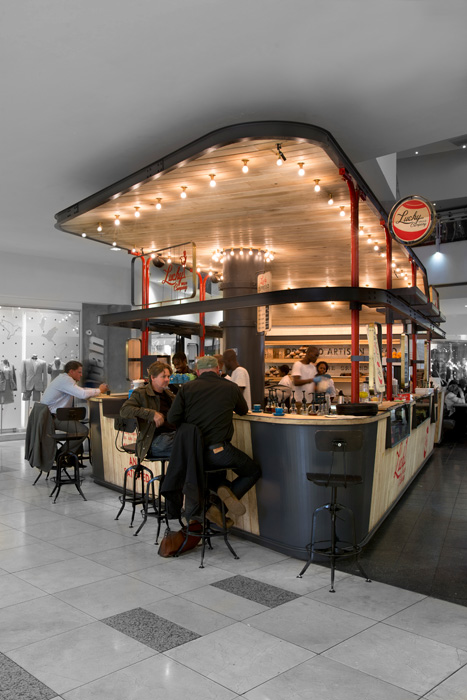Earthworld has been involved in interior architecture for a number of years and specifically in retail design for the last 10 years. Our contribution to the field of retail design is focused on the interior design of restaurants and food and drink outlets. Our design ethos is to create bespoke spaces with meaning and value. Our aim is not to, merely produce designs at high speed or in large quantities, but rather to craft each space in a unique way according to its distinctive requirements. Each of our retail designs are carefully considered in terms of context, user requirements, sustainability and budget. Of all our retail clients, The TriBeCa Coffee Company is the most significant. Other clients include exclusive outlets such as Foghound Coffee Company and Showroom, Delicious Carlton Café and Lucky Bread Company.
Currently the retail trend in South Africa is shifting from conventional purchasing to e-commerce. This drastic change has several remarkable effects: The most important effect is customer experience. Due to the fact that most goods can be purchased on-line, the experience of visiting a retail outlet or a mall is becoming more prominent. Online shopping is time and cost effective, but it is devoid of any spatial interaction and personal experience. The two significant factors which currently have an influence on the retail experience are technology and authenticity.
Technology in retail design has not yet reached its full potential in South Africa, opposed to other developed countries. Buzz words such as “app-based consumerism”, “mobile payments”, “gamified shop windows”, “augmented reality”, etc. are all part of the inevitable future of retail outlets retail outlets. In light of the reality of online shopping and augmented reality there is a strong notion that retail outlets will soon become more showroom orientated with limited stock due to purchases being made online.
Authenticity is vital in our ever increasing digitalised environment. The nostalgic notion of going back to the lives of our predecessors, who purchased “bread from the bakery around the corner” and “seafood from the fish monger down the street” is a very appealing trend and it is becoming more prominent. This becomes apparent through the concept of satellite stores within a store and the current popularity of local food and goods markets.
Over the last ten years, the retail trend has shifted from mass produced products to customised, handcrafted artisan products. This trend goes hand-in-hand with the notion of authenticity. (This is prevalent in craft beer, freshly ground barista coffee, etc.) The retail trends in South Africa are similar to international trends, with the exception that South Africa remains a country with a large inequality in terms of income distribution. This has the effect that there will probably always be two different realms of retail; the informal and formalized. There is however great opportunities in bridging these two realms and through doing so create a very unique South African retail identity.
The projects we did for TriBeCa Coffee Company our approach to retail trends are to create spaces which enhance the experience of the user and to tap into the notion of authenticity. Our goal was to create eating and drinking spaces, which recalls the nostalgic notion of a by-gone era when everything was hand produced or hand crafted and people had more time to enjoy food and drink. However, we as a company strive to construct tailored spaces that are unique according to each client’s need. We therefore, do not restrict ourselves to a specific design language or spatial look and feel.
Considering popular themes relevant in retail design, technology and authenticity are again the two main considerations. To enhance the movement towards technology in retail design, the ultra-sleek space is very relevant. High-tech materials and lighting are used to create an ambiance of intelligibility. The other important theme is the idea of the handcrafted, authentic and texture-rich spaces. This notion emerged as the counter reaction to the increase in virtually. To create this authentic ambiance, materials such as steel, brass, copper, textiles and wood are appropriated to achieve the specific feel through an understanding of the materials’ inherent character or nature.
Considering the fact that tailoring purpose made spaces according to the client’s unique requirements is our design ethos, the level of sustainability will vary from one project to another and will be suited according to the budget. One “green” consideration that we strongly pursue with our retail design, especially with TriBeCa, is to create a timeless, tactile design that will achieve a degree of longevity. Retail space with a short lifespan that are changed frequently often wastes energy and materials. This can be addressed through a well-considered design and high quality spatial elements and materials.
Our forecast for retail design in South Africa is that, as more people get comfortable with online shopping, the experience factor in retail design will even become more important. We foresee that there will be two main trends through which retail experience will be created. Both are appropriate, thus establishing an “and/or” approach. The first trend prediction is that the idea of pop-up shops will become more popular. Pop-up shops create the element of surprise, exclusivity and delight which generates a complete contrast to online shopping. The notion of a store that only exists for a short while is relevant in our lifetime where satisfaction or even boredom is easily reached. E-commerce can be complimented with pop-up shops, where commodities can be viewed or tested by clients and then be purchased on-line. Although pop-up shops do not have longevity, it can still be considered a sustainable design practice when the structures can be disassembled and reused to create something else. The second expectation is the polar opposite to the notion of pop-up shops: We predict that long term retail outlets, especially restaurants will become more prevalent. The realisation that it is not economically and environmentally sustainable to change retail design on a regular basis causes this trend. The concept of retail spaces that are designed and built to last 20 to 30 years, such as the “the café on the corner” is exceedingly alluring in our fast-paced, ever-changing lives.


